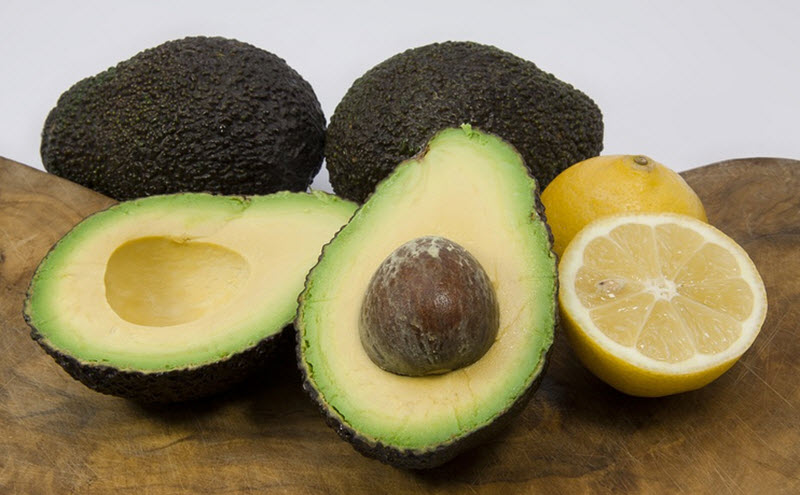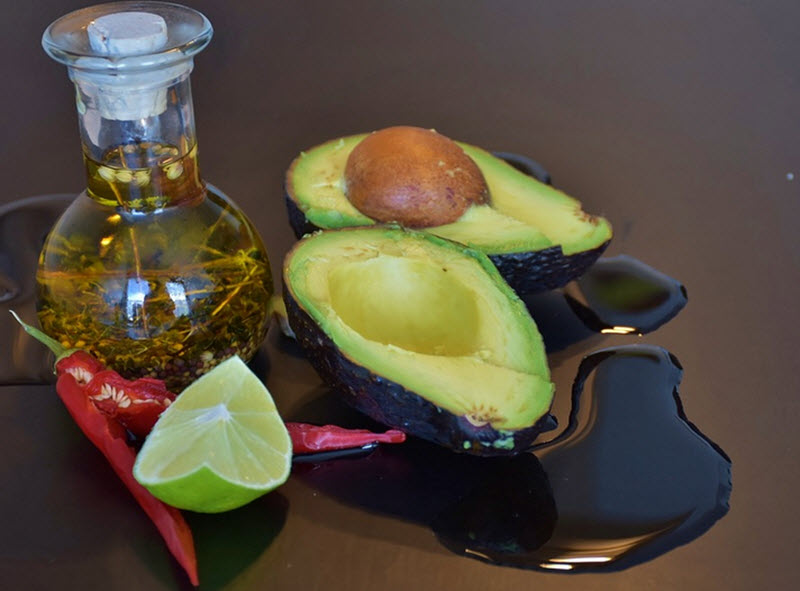Contents

Avocado (Persea americana) is a tree native to Mesoamerica. The desirable avocado fruit, also known as alligator pear, contains one large seed surrounded by a thick layer of greenish to yellow edible pulp. The pulp is very fatty – about 75% of an avocados energy content comes from fat. From a botanical perspective, the avocado is a berry, not a fruit.
There are many different types of avocado, varying in size, shape, taste, texture and nutritional content. The inside can be anywhere from pale yellow to strong green, while the exterior vary from bright green to a green shade that is so dark it looks almost black. The exterior can be smooth or rough. When it comes to shapes, we usually see pear shaped avocados in the United Kingdom, but round avocadoes also exist as well as avocados with highly elongated and sometimes even bent “necks”. Large avocados weigh nearly 1.5 kg but these giants are rare in the trade outside the avocados native region.
One of the most well-known avocado cultivars is the Hass avocado, since it is the dominant cultivar among commercial Mexican avocado farmers and Mexico supplies 45% of the international avocado market. Hass also accounts for 80% of the U.S. avocado production. A Hass avocado is pear-shaped with a dark green skin that is rough and bumpy. When the avocado is ripe, the skin develops a dark purplish-black color and the fruit will yield to gentle pressure. In the trade, a typical Hass will weigh 200 – 300 grams. It’s named after Southern California amateur horticulturist Rudolph Hass. All Hass avocado plants in the world hail from grafted seedlings propagated from a single tree grown from seed by Rudolph Hass in the 1920s. One of the reasons to why the Hass avocado became such a huge commercial success is the fruits long shelf-life. It is also a high-yielding cultivar that can be harvested year round.

Avocado fat
Fruits and berries tend to be sweet with a large amount of the total caloric value coming from sugars. The avocado distinguishes itself by having roughly 75% of its calories in the form of fat, making it one of the fattiest plant foods in existence.
The avocado isn’t just rich in fat, it also has an interesting fat profile.
- For a typical store-bought avocado, roughly two-thirds of the fat will be oleic fat (omega-9 fat) and 6% will be palmitoleic fat (omega-7 fat). Both oleic and palmitoleic fat are monosaturated fat.
- Less than 15% of the fat in a standard avocado will be saturated fat.
- Roughly 14% of the fat in an avocado is omega-6 fat and just 1% of the fat in an avocado is omega-3 fat.
Here are few examples of interesting studies about oleic acid and heath:
Oleic acid promotes apoptotic cell death of breast cancer cells
Oleic acid content is responsible for the reduction in blood pressure induced by olive oil
An overview of the modulatory effects of oleic acid in health and disease
Fat and nutrient absorption
 Not only is the fat in avocados good for you on its own – it can also help you absorb other nutrients better. Examples of fat soluble vitamins are A, D, E and K. The famous antioxidant carotenoid is also fat soluble and more readily absorbed by the human digestive tract when eaten together with fat. This study shows that adding avocado or avocado oil to green salad or tomato salsa can increase the antioxidant absorption dramatically. So, combining red salsa with avocado in a Delicious TexMex inspired meal can really be a good idea, or why not add some avocado oil as salad dressing on your shredded carrots the next time you feel like boosting your carotenoid intake.
Not only is the fat in avocados good for you on its own – it can also help you absorb other nutrients better. Examples of fat soluble vitamins are A, D, E and K. The famous antioxidant carotenoid is also fat soluble and more readily absorbed by the human digestive tract when eaten together with fat. This study shows that adding avocado or avocado oil to green salad or tomato salsa can increase the antioxidant absorption dramatically. So, combining red salsa with avocado in a Delicious TexMex inspired meal can really be a good idea, or why not add some avocado oil as salad dressing on your shredded carrots the next time you feel like boosting your carotenoid intake.
Vitamins
A 100 gram serving of standard avocado is moderate to rich in several B-vitamins and in vitamin K. It is also a good source of vitamin C and vitamin E.
Minerals
Avocado is a great source of potassium. The banana has become the poster child of proper potassium intake, but 100 grams of a typical store-bought avocado will give you roughly 485 mg potassium which is 10% of the recommended daily intake for an adult. 100 grams of a standard store-bought banana will only provide you with 22 mg potassium.
Keeping an optimal balance of potassium and sodium in the body is important, but many of us eat way too much sodium and too little potassium. Getting enough potassium is associated with a significantly lower risk of stroke. Diets low in potassium can lead to both hypertension and hypokalemia. Potassium is necessary to maintain electrical gradients in the cells.
Fiber
Avocado is a rich source of fiber, and a standard avocado will give you approximately 7 grams of fiber in a 100 gram serving. Roughly three quarters of the fiber in an avocado is insoluble fiber while the rest is soluble fiber.
UK health authorities recommends a daily fiber intake of at least 18 grams per day for an adult. Eating a 200 gram avocado would thus put you well on your way towards this goal, since the avocado would contain about 14 grams of fiber.
A sufficient fiber intake will reduce the risk of constipation, colo-rectal cancer, diverticulitis and diabetes. A high fiber diet can also reduce cholesterol levels.
For fiber to provide optimal protection against constipation, an increased fiber intake should be accompanied by an increased fluid intake.
Fiber, especially fermentable fiber, can aid the important bacterial microflora in the human digestive system.
USDA nutritional profile for raw avocado
Source: http://ndb.nal.usda.gov/ndb/search/list?qlookup=09037&format=Full
| Nutritional value per 100 g | |
| Energy | 160 kcal |
| Carbohydrates | 8.53 g |
| Sugars | 0.66 g |
| Dietary fiber | 6.7 g |
| Fat | 14.66 g |
| Saturated | 2.13 g |
| Monounsaturated | 9.80 g |
| Polyunsaturated | 1.82 g |
| Protein | 2 g |
| Vitamins | |
| Vitamin A equiv.
beta-carotene lutein zeaxanthin |
(1%)
7 μg (1%) 62 μg 271 μg |
| Thiamine (B1) | (6%)
0.067 mg |
| Riboflavin (B2) | (11%)
0.13 mg |
| Niacin (B3) | (12%)
1.738 mg |
| Pantothenic acid (B5) | (28%)
1.389 mg |
| Vitamin B6 | (20%)
0.257 mg |
| Folate (B9) | (20%)
81 μg |
| Vitamin C | (12%)
10 mg |
| Vitamin E | (14%)
2.07 mg |
| Vitamin K | (20%)
21 μg |
| Minerals | |
| Calcium | (1%)
12 mg |
| Iron | (4%)
0.55 mg |
| Magnesium | (8%)
29 mg |
| Manganese | (7%)
0.142 mg |
| Phosphorus | (7%)
52 mg |
| Potassium | (10%)
485 mg |
| Sodium | (0%)
7 mg |
| Zinc | (7%)
0.64 mg |
| Other constituents | |
| Water | 73.23 g |
| Fluoride | 7 µg |
Acoadoes and heart disease
 Certain blood markers are associated with an increased risk of certain heart conditions. Examples of such blood markers are total cholesterol levels and blood triglyceride levels. Also, a high level of HDL cholesterol and a low level of LDL cholesterol are associated with a lower risk of heart disease.
Certain blood markers are associated with an increased risk of certain heart conditions. Examples of such blood markers are total cholesterol levels and blood triglyceride levels. Also, a high level of HDL cholesterol and a low level of LDL cholesterol are associated with a lower risk of heart disease.
The impact of avocado on these blood markers has been studied in several human trials, although most of them have been short-term trials and they can therefore not provide us with long-term information. Still, if you are interested in avocado and heart health, you might want to check out some of them:
Effects of avocado as a source of monounsaturated fatty acids on plasma lipid levels
Effect of a high-monounsaturated fat diet enriched with avocado in NIDDM patients
Short-term impact of a diet rich in avocado includes a reduction of total cholesterol levels, a reduction of blood triglycerides, a reduction of LDL cholesterol (“bad cholesterol”) and an increase of HDL cholesterol (“good cholesterol”).
Eye health
Avocado is a good source of phytostelrols and caratoneoids, including lutein and zeaxanthin.
Lutein and zeaxanthin are important for the health of the human eye. Getting sufficient amounts of lutein and zeaxanthin in the diet will reduce the risk of cataracts and macular degeneration.
Eating avocados
If you want to speed up the ripening of a picked avocado, place it in room temperature together with an apple or any other fruit that emits ethylene gas.
Guacamole
Arguably the most famous avocado dish, guacamole is a dip made from mashed avocado and salt. It originated in what is now Mexico, and the name guacamole comes from an Aztec dialect via Nahuatl āhuacamolli. Since āhuacatl means avocado and molli is the word for sauce or concoction, the name guacamole literary means avocado sauce.
Originally, guacamole was mixed using a molcajete, a type of mortar and pestle, but you don’t need any special kitchen appliances to make guacamole. Ripe avocados are soft enough to be gently mashed with a fork or by hand.
Don’t be afraid to experiment with your guacamole and add various ingredients to suit your taste. Examples of popular additions are lime juice, minced garlic and chili flakes. Boiled eggs compliment the avocado nicely.
Allergies
- If you are allergic to latex, there is an increased risk of you being allergic to avocado as well. This is known as the latex-fruit syndrome.
- People with tree-pollen allergy can develop local symptoms in the mouth and throat shortly after eating avocado.
About avocadoes
| Scientific classification | |
| Kingdom: | Plantae |
| (unranked): | Angiosperms |
| (unranked): | Magnoliids |
| Order: | Laurales |
| Family: | Lauraceae |
| Genus: | Persea |
| Species: | Persea americana |
| Binomial name | |
| Persea americana | |
There is no native Mesoamerican animal that will swallow the avocado pit whole and thereby help with seed dispersal. Evolutionary biologist Daniel H. Janzen has suggested that the avocado was developed when megafauna animals such as the giant ground sloths and various gomphotheres species still roamed the land in Mesomerica. When these animals died out, the avocado managed to survive anyway.
It is possible that humans, due to our love of the nutritious avocado, knowingly or unknowingly took over the task of seed dispersal when the giant animals disappeared. Humans do not eat and excrete the pit, but we can bring avocados with us from one location to another.
